An in depth report in the New Yorker shows that a lot of the funding for the tea party movement comes via Charles and David Koch (Koch Industries). The billionaire's money is the backing behind the pep rallies. They've tried hard to stay "under the radar," but this report uncovers their anti-tax libertarian roots, beginning with the fact that their father was a founding member of the John Birch Society. At the time, he thought Dwight D. Eisenhower was a closet communist. Whoa, Nelly!
The little guy gets suckered into following the fat cat agenda, with the bait of a "No Taxes! Period." mantra. I know that the Koch's can live without public institutions; they'll toss bones to private institutions they like. Meanwhile, the public infrastructure will crumble. Will the little guy be happy when his kid's school falls apart? When the roads and bridges are unsafe? Any tax support is "socialism" to this faction. Unfortunately, it has traction.
It's also interesting to note that the Koch's are "free marketers." That's right they want to fight for their right to pollute air and water at everyone else's expense. It'll be okay, though, because they're patrons of the arts.
Terry Gross interviews Jane Mayer here.
Frank Rich picks up the ball here.
Their discrete operations are coming into the light of day.
Tuesday, August 31, 2010
Tuesday, August 24, 2010
DIY Project
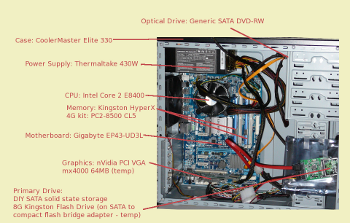 Here
Hereis my latest PC assembly project. I went the "do it yourself" route and I used parts similar to those that I mentioned here. I can't say that it's the cheapest PC out there, though. I see that Staples has an Acer desktop on their ad for $300. I hope that the adage "you get what you pay for" is true because the Staple's system looks to be a good bargain in comparison.
One thing which I was able to test with this system is running from a flash based live Linux distribution. The flash drive holds an 8G image of Slackware 13.1. The image is used as the basis for a device mapper snapshot. The "top" layer is allocated from RAM (tmpfs). By default the Linux kernel will allocate half of RAM for use by tmpfs, about 2G in this case. I used all of that for the snapshot (with loop0 pointing to the allocated file). From my initrd environment, I used this command sequence:
# dd if=/dev/zero of=/tmpfs/z
# losetup -f /tmpfs/z
# echo 0 $(blockdev --getsize /dev/sda1) snapshot /dev/sda1 /dev/loop0 p 32 | dmsetup create top
Note that by using RAM as the top layer, I avoid writing anything at all to flash. This is by design to prevent failures due to too many R/W cycles. In effect the flash layer is readonly; changes go to the top layer. A major benefit of using flash memory for the readonly layer is that it is orders of magnitude faster than optical disc (because optical disc seek time is so very slow.) The technique is described here.
Update: 2010-08-26
Here is some information about the E8400 CPU as seen by the Linux kernel:
bash-4.1$ cat /proc/cpuinfo
processor : 0
vendor_id : GenuineIntel
cpu family : 6
model : 23
model name : Intel(R) Core(TM)2 Duo CPU E8400 @ 3.00GHz
stepping : 10
cpu MHz : 3000.068
cache size : 6144 KB
physical id : 0
siblings : 2
core id : 0
cpu cores : 2
apicid : 0
initial apicid : 0
fdiv_bug : no
hlt_bug : no
f00f_bug : no
coma_bug : no
fpu : yes
fpu_exception : yes
cpuid level : 13
wp : yes
flags : fpu vme de pse tsc msr pae mce cx8 apic sep mtrr pge mca cmov pat pse36 clflush dts acpi mmx fxsr sse sse2 ss ht tm pbe nx lm constant_tsc arch_perfmon pebs bts aperfmperf pni dtes64 monitor ds_cpl vmx smx est tm2 ssse3 cx16 xtpr pdcm sse4_1 xsave lahf_lm tpr_shadow vnmi flexpriority
bogomips : 6000.13
clflush size : 64
cache_alignment : 64
address sizes : 36 bits physical, 48 bits virtual
power management:
processor : 1
vendor_id : GenuineIntel
cpu family : 6
model : 23
model name : Intel(R) Core(TM)2 Duo CPU E8400 @ 3.00GHz
stepping : 10
cpu MHz : 3000.068
cache size : 6144 KB
physical id : 0
siblings : 2
core id : 1
cpu cores : 2
apicid : 1
initial apicid : 1
fdiv_bug : no
hlt_bug : no
f00f_bug : no
coma_bug : no
fpu : yes
fpu_exception : yes
cpuid level : 13
wp : yes
flags : fpu vme de pse tsc msr pae mce cx8 apic sep mtrr pge mca cmov pat pse36 clflush dts acpi mmx fxsr sse sse2 ss ht tm pbe nx lm constant_tsc arch_perfmon pebs bts aperfmperf pni dtes64 monitor ds_cpl vmx smx est tm2 ssse3 cx16 xtpr pdcm sse4_1 xsave lahf_lm tpr_shadow vnmi flexpriority
bogomips : 5999.07
clflush size : 64
cache_alignment : 64
address sizes : 36 bits physical, 48 bits virtual
power management:
And, some relative scores here.
My next project will most likely be a 64-bit machine for use with VMare ESX or QEMU+KVM. I am looking at a pair of Xeon 5520 CPUs. Or possibly, Xeon 5504 to save some bucks.
Update: 2010-12-01
Check this post for a similar project using flash as a primary storage media.
OpenSolaris on life support...
Friday, August 13, 2010
First Look at Snow Leopard
This week I happened to see an install of Mac OS X Snow Leopard (v10.6.4) on a
 Dell D620. My first impression was somewhat favorable, but read more below.
Dell D620. My first impression was somewhat favorable, but read more below.
From an aesthetic perspective, it looks nice. However, Apple has adapted OS X to conform with the way their desktop interface has always been presented. A big part of this design forces the active Window's menu to be located at the top bar and "untied" from the window itself. This is just wrong, a bad design. Too bad they didn't correct it when they had the chance at the cretaceous/tertiary boundary layer - oops, I mean at the v9 to v10 transition. (Aside: It's funny that MS Vista and Windows 7 have somewhat copied this error and have removed perfectly functional menus in the name of a "cleaner" look. I am definitely in the "minimalist" design school, but removing the menu entirely is wrong, too.) From the Law: Every application that uses a menu should place it below its own title bar.
Continuing on, I downloaded some core and essential applications to make comparisons. I chose Firefox, Skype, and OpenOffice as representative cross platform applications. I found that each of these are truly cross platform and work the same way across all three platforms (Linux, Mac OS X, Windows). Notably, OpenOffice is now a native "Cocoa" application under Mac OS X and no longer requires the X11 layer. In the end all of these are equally "functional" and equally "beautiful" regardless of platform. This category is more or less a tie.
Next, I gave quicktime and iTunes the abiility to play ogg files with the quicktime component. (By the way, I think you need to logout after installing the xiph library thingy; otherwise, it doesn't become active.) When I wasn't sure this was working, I downloaded a more general sound program, sox. Interestingly, this program just segfaults. This is strange and smacks of direct breakage/interfence from Apple. Aye, there's the rub. I am not ready to trade one monopolist's tactics for the other's.
Continuing on, I took a quick glance around the environment to see if there was any thing which is driving the masses to switch in droves to the new and cool platform. The calendar application, iCal looks very nice. The Dashboard thingy is nice but I don't know how to set it into a usable desktop background mode. Its default behaviour "returns" it to the dock- what's the point of that? I had been more or less avoiding it, but finally opened iTunes, Apple's flagship application. I was immediately assaulted by the expletive-ing billboard that appears for Apple's "chosen". It is definitely in the Real Player, Microsoft Media Player school of design which copies the television metaphor for both passive activity, and ad supported content. Really, that's it? That's the greatest thing since sliced bread?
But just for the sake of argument, let's say you can ignore its flaws and its blatant commercialism, and you just want to use it as another "unix" platform and adapt it for your intended purpose. OS X (Darwin at its core) is a FreeBSD derivative, therefore, I assume you should be able to use "ports" to compile new applications from source. To do this, the first thing you'll need is a compiler. I found that you can get the tools necessary from something Apple calls xcode. But to get that, you'll have to register as an Apple developer first. Its's ironic when you jump through that hoop, the payoff is the GPL licensed toolset, with the gcc compiler at heart. (It's not clear to me if FreeBSD has its own compiler, or also relies on the GPL toolset.) Obviously, Apple doesn't have any qualms about taking "free" tools, and not worrying about giving back- either in the spirit or letter of the law.
I've seen enough. There is nothing compelling and I'll be sticking with Slackware.
 Dell D620. My first impression was somewhat favorable, but read more below.
Dell D620. My first impression was somewhat favorable, but read more below.From an aesthetic perspective, it looks nice. However, Apple has adapted OS X to conform with the way their desktop interface has always been presented. A big part of this design forces the active Window's menu to be located at the top bar and "untied" from the window itself. This is just wrong, a bad design. Too bad they didn't correct it when they had the chance at the cretaceous/tertiary boundary layer - oops, I mean at the v9 to v10 transition. (Aside: It's funny that MS Vista and Windows 7 have somewhat copied this error and have removed perfectly functional menus in the name of a "cleaner" look. I am definitely in the "minimalist" design school, but removing the menu entirely is wrong, too.) From the Law: Every application that uses a menu should place it below its own title bar.
Continuing on, I downloaded some core and essential applications to make comparisons. I chose Firefox, Skype, and OpenOffice as representative cross platform applications. I found that each of these are truly cross platform and work the same way across all three platforms (Linux, Mac OS X, Windows). Notably, OpenOffice is now a native "Cocoa" application under Mac OS X and no longer requires the X11 layer. In the end all of these are equally "functional" and equally "beautiful" regardless of platform. This category is more or less a tie.
Next, I gave quicktime and iTunes the abiility to play ogg files with the quicktime component. (By the way, I think you need to logout after installing the xiph library thingy; otherwise, it doesn't become active.) When I wasn't sure this was working, I downloaded a more general sound program, sox. Interestingly, this program just segfaults. This is strange and smacks of direct breakage/interfence from Apple. Aye, there's the rub. I am not ready to trade one monopolist's tactics for the other's.
Continuing on, I took a quick glance around the environment to see if there was any thing which is driving the masses to switch in droves to the new and cool platform. The calendar application, iCal looks very nice. The Dashboard thingy is nice but I don't know how to set it into a usable desktop background mode. Its default behaviour "returns" it to the dock- what's the point of that? I had been more or less avoiding it, but finally opened iTunes, Apple's flagship application. I was immediately assaulted by the expletive-ing billboard that appears for Apple's "chosen". It is definitely in the Real Player, Microsoft Media Player school of design which copies the television metaphor for both passive activity, and ad supported content. Really, that's it? That's the greatest thing since sliced bread?
But just for the sake of argument, let's say you can ignore its flaws and its blatant commercialism, and you just want to use it as another "unix" platform and adapt it for your intended purpose. OS X (Darwin at its core) is a FreeBSD derivative, therefore, I assume you should be able to use "ports" to compile new applications from source. To do this, the first thing you'll need is a compiler. I found that you can get the tools necessary from something Apple calls xcode. But to get that, you'll have to register as an Apple developer first. Its's ironic when you jump through that hoop, the payoff is the GPL licensed toolset, with the gcc compiler at heart. (It's not clear to me if FreeBSD has its own compiler, or also relies on the GPL toolset.) Obviously, Apple doesn't have any qualms about taking "free" tools, and not worrying about giving back- either in the spirit or letter of the law.
I've seen enough. There is nothing compelling and I'll be sticking with Slackware.
Wednesday, August 11, 2010
En guarde...
Do you trust your computer to keep your secrets? Your diary and your recipes are one thing, but your bank account numbers (and passwords) are another. So what if you lose a cake recipe, but what happens if your bank account is accessed without your knowledge? At least, some people are starting to realize their potential for loss and the potential downside of blindly trusting their computers:
 .
.
Even though they've noticed, it's not clear that they're prepared to do anything about it. There is no real change in attitude. First of all, they could look for a safer platform to use that would help to minimize the threat. It's as if Ralph Nader were to write an expose calling Windows the Corvair of software, "unsafe at any speed," but his warning goes unheeded because, hey, I like that car...
 .
.Even though they've noticed, it's not clear that they're prepared to do anything about it. There is no real change in attitude. First of all, they could look for a safer platform to use that would help to minimize the threat. It's as if Ralph Nader were to write an expose calling Windows the Corvair of software, "unsafe at any speed," but his warning goes unheeded because, hey, I like that car...
Sunday, August 8, 2010
Herbert's Commentary in NY Times
In my opinion, we're not out of this severe recession/depression yet. 10% (reported) unemployment is the elephant in the room. We've traded a big sector of our manufacturing economy in return for (initially) cheaper imports. It's a big question where the laid off workers will find new jobs or retraining in industries still in demand. Even in this economic climate, one area which has remained largely intact is our education system. An educated workforce is essential in today's knowledge based economy. Even though our primary education system can vary widely, and may not match the "Brady Bunch" and "Wonder Years" ideal, at least our university system remains the envy of the world. Foreign students have flocked to the US to receive a "world class" upper-level education. The economic impact can be beneficial for everyone. The universities receive tuition to import students. The student becomes an exported quantity back to his origin, where he can use his skills to level the playing field among all countries. But as the recession/depression lingers, our education system may get bigger cuts as state budgets tighten further. It's a nasty downward spiral, and I'm not sure we'll be able to "pull up" in time. Today's editorial by Herbert in the NY Times is on target.
p.s. Modern economic theory says that recessions/depressions are unnecessary. Spending and the money supply can/should be manipulated to keep the economy humming on all cylinders. This theory is showing some signs of breakage as politicians are showing fear of endlessly increasing deficits. The Keyensian model may work only in a vacuum, and under ideal conditions when more goods and services are necessary. What happens when it is not clear what should be produced? The common anecdote questions whether people should be paid for "digging holes, and filling them back in." It keeps people busy, but does it add to the goods and services that people actually want? The obvious flip side is paying for extended unemployment benefits. There is a lot of wasted labor built into the model already. Couldn't the US benefit from some form of "planned economy" where we get the goods and services we need? It's ironic we can pay for unemployment, but can't pay for teachers to improve our schools, or pay for workers to fix our failing infrastructure, etc. etc.
Update: 2010-08-09
Krugman amplifies the same theme.
Update: 2010-08-13
The radio show On Point discusses the potential for deflation and a continuing downward spiral similar to the Japanese scenario of the 1990s. I have read a fair number of Richard Russell's Dow Theory Letters, and he is fond of saying that the Federal Reserve's entire mission statement can be summarized as "inflate or die." Several of the guests on this radio program expressed their fear of deflation in the same way; they'd rather have runaway inflation than deflation. (This is why Richard Russell refers to all paper currencies as "fiat currencies." All national money supplies are subject to arbitrary internal manipulations, and all national currencies are competing against each other to stay in the same relative ballpark, lest trade be disrupted. National currencies are supposed to be traded commodities- allowed to rise and fall according to market conditions- but some nations are not playing the game; they are undervaluing their currency to prop up exports. In any case, the net effect, is still a race to the bottom for all paper currencies.)
p.s. Modern economic theory says that recessions/depressions are unnecessary. Spending and the money supply can/should be manipulated to keep the economy humming on all cylinders. This theory is showing some signs of breakage as politicians are showing fear of endlessly increasing deficits. The Keyensian model may work only in a vacuum, and under ideal conditions when more goods and services are necessary. What happens when it is not clear what should be produced? The common anecdote questions whether people should be paid for "digging holes, and filling them back in." It keeps people busy, but does it add to the goods and services that people actually want? The obvious flip side is paying for extended unemployment benefits. There is a lot of wasted labor built into the model already. Couldn't the US benefit from some form of "planned economy" where we get the goods and services we need? It's ironic we can pay for unemployment, but can't pay for teachers to improve our schools, or pay for workers to fix our failing infrastructure, etc. etc.
Update: 2010-08-09
Krugman amplifies the same theme.
Update: 2010-08-13
The radio show On Point discusses the potential for deflation and a continuing downward spiral similar to the Japanese scenario of the 1990s. I have read a fair number of Richard Russell's Dow Theory Letters, and he is fond of saying that the Federal Reserve's entire mission statement can be summarized as "inflate or die." Several of the guests on this radio program expressed their fear of deflation in the same way; they'd rather have runaway inflation than deflation. (This is why Richard Russell refers to all paper currencies as "fiat currencies." All national money supplies are subject to arbitrary internal manipulations, and all national currencies are competing against each other to stay in the same relative ballpark, lest trade be disrupted. National currencies are supposed to be traded commodities- allowed to rise and fall according to market conditions- but some nations are not playing the game; they are undervaluing their currency to prop up exports. In any case, the net effect, is still a race to the bottom for all paper currencies.)
Thursday, August 5, 2010
GUI setup tools to configure Slackware 13.x's wireless networks
Here are a couple of screenshots which show how to setup wireless networks using the tool, wicd. This tool makes setting network parameters very easy and intuitive; and it does not require using command line tools. The tool/icon offers information about wireless networks in a way that is very similar to the tools available under other operating systems (Windows, Mac OS X, etc.)
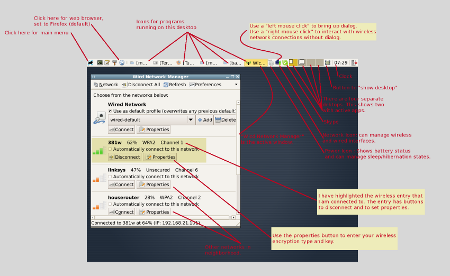 .
.
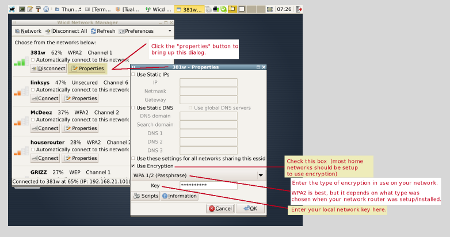 .
.
The platform is Slackware 13.x and the window manager is XFCE with very little customization.
 .
. .
.The platform is Slackware 13.x and the window manager is XFCE with very little customization.
Tuesday, August 3, 2010
Where did I put the recovery disk?
Monday, August 2, 2010
Linux : A new kernel release
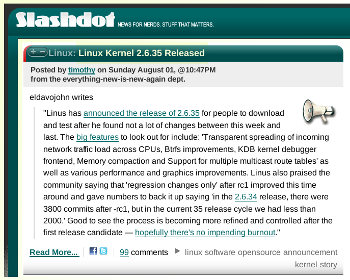 .
.Linux kernel development continues unabated. I want to check out the btrfs filesystem improvements, because it looks like it is positioned to become the primary filesystem type in the near future. Currently, I use XFS, but may switch depending on the results of some performance tests using snapshots.
Subscribe to:
Posts (Atom)
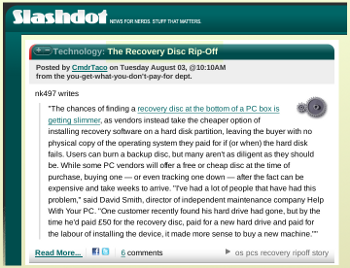 .
.